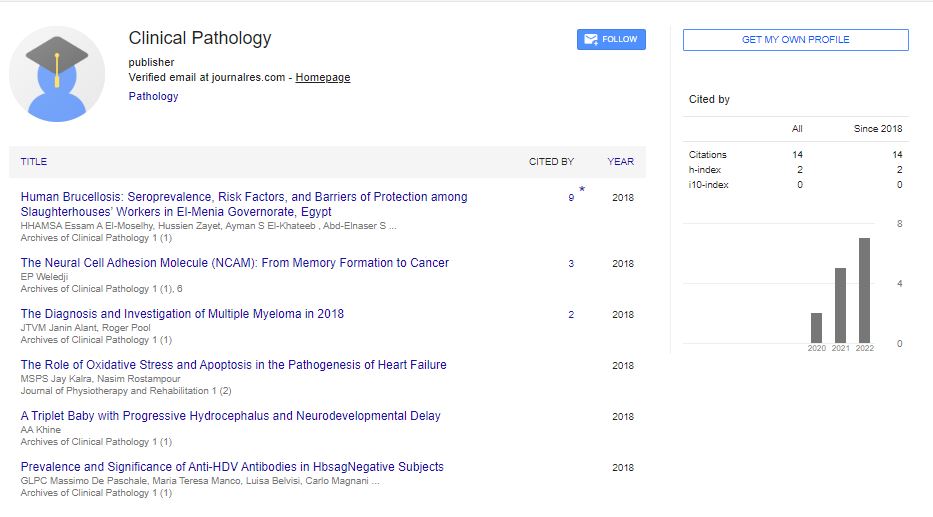Opinion Article, Arch Clin Pathol Vol: 8 Issue: 1
The Function of Cytopathology in the Early Detection and Prevention of Cancer
Sule Ivana*
Department of Anatomical Pathology, University of Notre Dame, Sydney, Australia
*Corresponding Author: Sule Ivana
Department of Anatomical
Pathology, University of Notre Dame, Sydney, Australia
E-mail: ivana.sule@und.au
Received date: 28 May, 2023, Manuscript No. ACPY-23-107063
Editor assigned date: 31 May, 2023, Pre QC No. ACPY-23-107063 (PQ);
Reviewed date: 14 June, 2023, QC No. ACPY-23-107063
Revised date: 22 June, 2023, Manuscript No. ACPY-23-107063 (R);
Published date: 28 June, 2023, DOI: 2324-8955/acpy.05.03.100086
Citation: Ivana S (2023) The Function of Cytopathology in the Early Detection and Prevention of Cancer. Arch Clin Pathol 6:2.
Description
Cytopathology plays a significant role in the early detection and prevention of cancer. It is a branch of pathology that focuses on the study of cellular changes to diagnose and characterize diseases, particularly cancer. By examining cells obtained from various body sites, cytopathologists can identify abnormal cellular changes that may indicate the presence of cancer or precancerous conditions. This allows for early intervention and treatment, ultimately improving patient outcomes.
One of the primary functions of cytopathology is the screening of individuals at risk for cancer. Through techniques such as Pap smears, which examine cells from the cervix, and liquid-based cytology, which analyzes cells from other sites like the respiratory tract, cytopathologists can identify precancerous or early-stage cancerous changes. These screening tests aim to detect cellular abnormalities before the development of symptoms or the formation of visible tumors, enabling early intervention and a higher chance of successful treatment.
In the field of gynecologic cytopathology, the Pap smear has been instrumental in the early detection of cervical cancer. This simple and cost-effective test involves the collection of cells from the cervix and their examination under a microscope. Abnormalities such as dysplasia, which is the presence of abnormal cells, can be detected and further evaluated for the presence of Human Papillomavirus (HPV) infection, a common risk factor for cervical cancer. Early identification of precancerous changes allows for timely interventions such as colposcopy and biopsy, which can confirm the presence of Cervical Intraepithelial Neoplasia (CIN) and guide appropriate management.
Beyond gynecologic cytopathology, the use of Fine Needle Aspiration (FNA) has revolutionized the early diagnosis of various cancers. FNA involves the extraction of cells or small tissue samples from suspicious lesions using a fine needle, which are then analyzed by cytopathologists. This technique is commonly used for the evaluation of palpable or radiologically identified nodules in organs such as the breast, thyroid, lung, and lymph nodes. It allows for rapid and minimally invasive diagnosis, facilitating early treatment decisions.
Cytopathology also plays a role in cancer prevention through the identification of precancerous lesions. In the case of cervical cancer, the detection of high-risk HPV types in conjunction with abnormal cervical cytology can guide the management of patients with precancerous lesions. Follow-up interventions, such as repeated Pap smears, HPV testing, or colposcopy, can help monitor and manage these individuals to prevent the progression to invasive cancer.
Additionally, cytopathology is instrumental in guiding personalized treatment strategies for cancer patients. The analysis of tumor cells obtained through fine needle aspiration or other methods allows for the characterization of specific molecular markers, such as hormone receptors or genetic mutations. This information is important for determining the most effective treatment options, including targeted therapies or immunotherapies, and for monitoring treatment response.
Moreover, cytopathology plays a role in cancer surveillance and monitoring. Through repeated cytological examinations, cytopathologists can track cellular changes over time and detect any signs of recurrence or disease progression. This ongoing monitoring is essential for the long-term management and care of cancer patients.
In conclusion, cytopathology plays a vital function in the early detection and prevention of cancer. By analyzing cellular changes, cytopathologists can identify precancerous and cancerous lesions, allowing for timely interventions and improved patient outcomes. Screening tests, such as Pap smears and FNA, facilitate the early detection of cellular abnormalities, enabling early treatment and preventing the progression to advanced stages of cancer. The use of cytopathology in personalized medicine also aids in tailoring treatment strategies to specific molecular markers and monitoring treatment response. Overall, cytopathology is a dire component of cancer care, contributing to the early detection, prevention, and management of this complex disease.
 Spanish
Spanish  Chinese
Chinese  Russian
Russian  German
German  French
French  Japanese
Japanese  Portuguese
Portuguese  Hindi
Hindi 